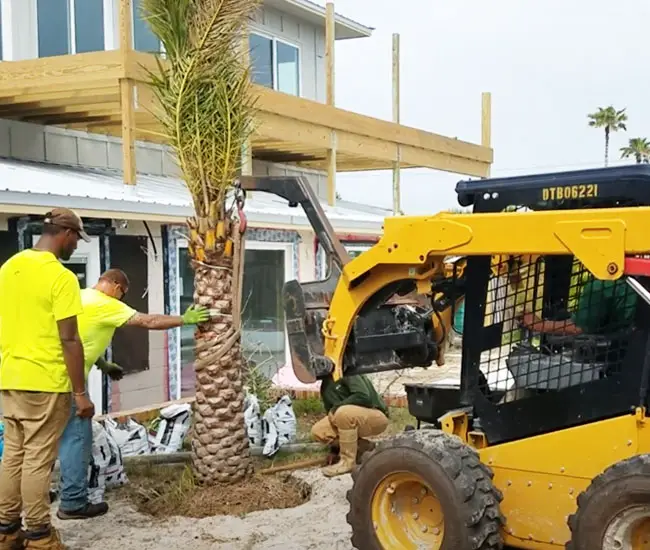
When it comes to relocating a palm tree from one spot to another, minimizing root damage and reducing stress factors is crucial.
Trust me, transplanting can get tricky, but with a little prep, you can dodge most of the mishaps. Check out these top 10 most common mistakes gardeners make when planting a large palm:
1. Planting Too Deep
Many gardeners mistakenly believe that burying a palm tree a few inches deeper is beneficial, creating what’s called a “water well.”
In reality, planting too deep can lead to water stress, nutrient deficiencies, and ultimately, the demise of the palm. Palms should always be planted at the same depth they were initially grown before transplanting.
If your palm arrived without a pot, ensure that the top of the root-shoot interface rests approximately one inch below the soil surface.
If you discover that your palm is too deeply planted and re-planting isn’t an option, carefully remove some soil from the top.
2. Planting Too High
While not as critical as planting too deep, positioning a palm too high can also be problematic. Palms with exposed roots are referred to as being “on their tiptoes” and can be unstable, potentially toppling over in strong winds.
Additionally, exposure to hot, dry air can damage the roots, impede growth, or even result in root death, ultimately leading to the decline of the palm.
Some palm enthusiasts deliberately plant palms slightly higher in anticipation of soil settling and the palm sinking over time. If you’ve planted your palm correctly, this should not be necessary.
If your palm is already too high and re-planting isn’t an option, consider adding a moisture-retaining layer around the base of the palm to protect existing roots and encourage new root growth.
Use native soil or compost for areas where roots are exposed, and opt for a well-draining layer with more air around the base if roots are just slightly covered with soil.
3. Leaving Air Pockets
Let’s tackle the next mistake, which is leaving air pockets in the soil. When you’re backfilling the hole, ensure there are no air pockets lurking about.
Here’s the trick – water the hole before planting, at the halfway point, and at the end. Otherwise, your root ball might sink over time, burying the palm too deep in the ground.
4. Root Pruning
Unlike broadleaf trees, palm tree roots don’t need to be pruned. Many palms rely on those old roots until their shiny new root system is up and running.
You see, palm roots sprout from a special spot on the stem called the “root initiation zone.” They grow to their maximum thickness but can’t pull off any secondary growth, although they do branch out.
Now, here’s the deal – if you’re digging up a palm from the ground during transplantation, try to keep that root ball as big as you can. It boosts the plant’s odds of making it through the move.
Oh, and resist the urge to strip away any of the original soil around the roots to keep those roots from getting exposed to the air.
But here’s a little twist – some palms, like the Sabal palmetto, shed all their roots during transplantation and need to start from scratch with new ones. So, for this species, it’s okay to have a smaller root ball.
5. Fertilizing Too Soon
Avoid placing fertilizer into the hole before planting the palm, as it can damage the palm’s roots by causing them to burn. Many people make this mistake and are then surprised to find their palm trees deteriorating.
Instead, wait until the palm has been transplanted and starts producing new growth, which typically occurs in about two months.
I highly recommend using a high-quality, slow-release fertilizer for your palm tree. Also, be cautious not to apply fertilizer too close to the trunk, as this can result in trunk damage.
Depending on the diameter of the trunk, it’s advisable to place the fertilizer approximately 1-2 feet away from the base.
During the initial few months after planting, you may also consider using a foliar fertilizer spray, especially since the palm won’t have developed its full root system to absorb nutrients from the soil.
However, keep in mind that foliar sprays are not as efficient as soil-based fertilizers because leaves can only absorb a fraction of the required nutrients for the palm.
6. Wrong Season
Planting during the wrong season can have adverse effects on your palm tree’s health. Depending on your local climate, planting too close to winter might not be advisable. After transplantation, it takes some time for the palm to develop a new root system.
Root growth significantly slows down when soil temperatures drop below 65°F and stops completely below 60°F. Without the development of new roots, the palm won’t be able to supply water to its leaves, which could jeopardize its survival during cold weather.
I recommend planting in the spring or early summer. This timing allows your palm ample opportunity to establish itself in its new location. Additionally, it’s wise to avoid planting during periods of drought to minimize stress on the plant.
7. Damaging Trunk
For the first 6-7 months after planting, it’s essential to provide support to large palm trees to prevent them from toppling over during windstorms.
When installing supporting blocks, avoid directly nailing them into the trunk of the palm. Wounds to the palm trunk are permanent and can make the palm susceptible to diseases.
Furthermore, when transplanting the palm, take precautions to protect the trunk. Wrap it with nylon slings before attaching chains, ropes, or cables. Any scratches or scrapes on the trunk will not heal and can lead to long-term damage.
8. Leaf Removal
To reduce water stress after transplanting, it can be beneficial to trim some of the older palm fronds. According to the University of Florida, certain species, such as Sabal palmetto, which lose all their roots during transplanting and have no means of accessing water for their leaves, can recover more quickly if all the leaves are removed.
However, it’s important to note that for other palm species, removing all the fronds can send them into shock. Therefore, the approach depends on the type of palm tree.
If you are uncertain, it’s advisable to remove no more than ¾ of the fronds when relocating a large, field-grown palm. Removing the middle leaves might even be fatal for the palm.
9. Keeping Leaves Tied Up
Many nurseries tie up palm leaves before transporting them to prevent damage. However, once the palm is in the ground, it’s crucial to untie the leaves.
Leaving them bound will not enhance growth and could create a favorable environment for palm diseases and insects.
10. Not Planting The Palm Right Away
Leaving the palm exposed with its roots exposed is the worst thing you can do. If you can’t plant the palm immediately, wrap the root ball in a damp tarp and regularly moisten it with a hose as needed to keep the root ball hydrated.
Conclusion
By following my step-by-step planting guide, you can avoid most of the common mistakes made by gardeners. However, it’s important to understand that even with great care, your palm may experience “transplant shock.”
This is normal, as the plant has been relocated to a new environment with different light levels, soil conditions, and humidity.
Additionally, the loss of roots reduces water intake, adding stress to the plant. Be patient and don’t expect significant new growth during the first year.
Related articles:
- Transplanting Palm Tree to a Bigger Container
- Palm Tree Planting Step-By-Step
- How To Move A Large Palm Without Killing It (with Pictures)
- Transplanting Palm Tree from a Container into the Ground

I do believe i have caused my spindle palm some harm after reading your information. Because most of the leaves were burned from displacement and the rest had begun to show orange like bruises, I cut them off. Have i killed my palm? Please help!
My landscaper in Lake Havasu City AZ wants to encase my palm trees in planters, raising the soil level 2 feet! He says that he will put lava rock around the tree trunks and wire in place so that the palms do not suffocate. I love my Queen Palms and do not want to do anything to stress or kill them. He is a well respected landscaper in town and doesn’t appreciate my concerns. Will the precautions of rocks around the trees prevent suffocating the roots? Thank you for your reply.
Great articles, keep up the good work
Thanks
Rw
I was told by a reputable nursery that planted my palms, to keep my Sylvester palm fonds tied up for 45 days. That is your mistake 9. Any advice?
I was told by a reputable nursery that planted my palms, to keep my Sylvester palm fonds tied up for 45 days. That is your mistake 9. Any advice? I’m worried now.